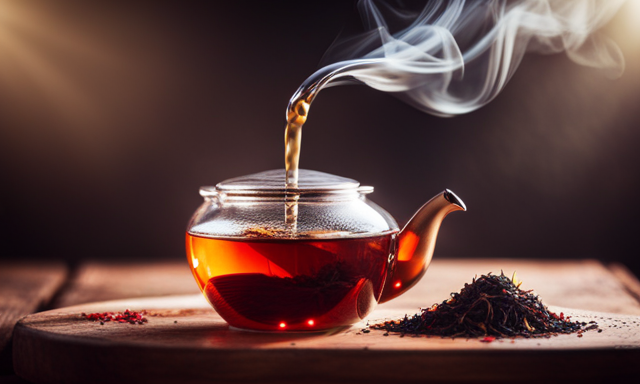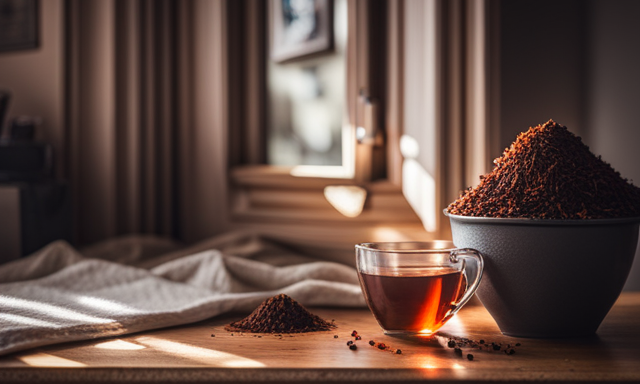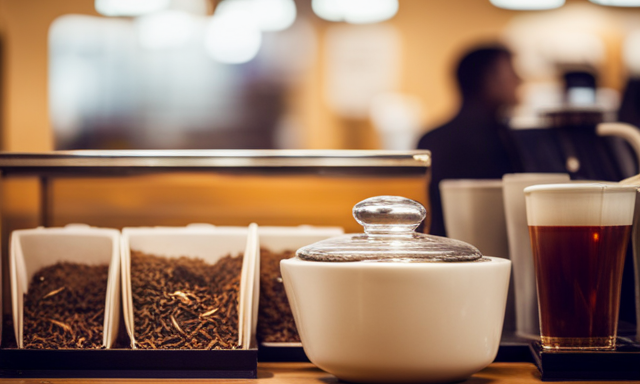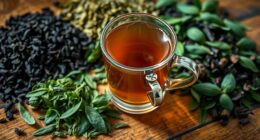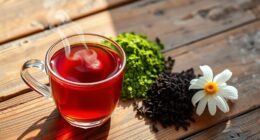Rooibos tea, a rejuvenating and richly flavored beverage, is a beloved brew that has captured the hearts of tea connoisseurs around the world. As an enthusiast myself, I am thrilled to share with you the art of preparing the perfect cup of rooibos tea.
From understanding its origins to exploring different varieties and blends, this article will guide you through each step with precision and expertise.
First and foremost, let me take you on a journey to the vibrant lands where rooibos tea originates. Then, I will enlighten you on the importance of selecting the finest rooibos leaves for an exquisite brew.
We will delve into the art of boiling water to the correct temperature, ensuring optimal flavor extraction. Next, I will reveal the secret to steeping the tea for just the right amount of time, unlocking its full potential.
And for those who desire a touch of sweetness or a burst of flavor, I will share optional additions to enhance your tea experience.
So, join me on this delightful exploration as we uncover the beauty of rooibos tea and savor every sip of this extraordinary beverage.
Key Takeaways
- Rooibos tea is naturally caffeine-free and packed with antioxidants.
- The ideal water temperature for brewing rooibos tea is 200 to 212 degrees Fahrenheit (93 to 100 degrees Celsius).
- Steeping time for rooibos tea is typically 5-7 minutes.
- Adding sweeteners or flavorings like honey or vanilla can enhance the taste of rooibos tea.
Understanding the Origins of Rooibos Tea
You’ll be amazed by the rich history and cultural significance behind the origins of rooibos tea. This wonderful beverage has been enjoyed for centuries by the indigenous people of South Africa.
The rooibos plant, scientifically known as Aspalathus linearis, is native to the Cederberg region of the Western Cape province. The local Khoisan people were the first to discover the extraordinary properties of this plant and began using it to make a delicious and refreshing tea.
Over time, rooibos tea gained popularity and became a staple in South African households. Today, it is loved worldwide for its unique taste and numerous health benefits. Rooibos tea is naturally caffeine-free and packed with antioxidants, making it a great choice for those looking to improve their overall well-being.
Now that we’ve learned about the origins and history of rooibos tea, let’s move on to the next section and explore how to choose the right rooibos tea leaves.
Choosing the Right Rooibos Tea Leaves
To ensure the perfect cup, it’s essential to select the ideal rooibos leaves for brewing. Choosing the right rooibos tea leaves is crucial in achieving the desired flavor and aroma.
Look for leaves that are vibrant in color, ranging from deep red to light amber, as this indicates freshness and quality. The leaves should also be whole and intact, without any signs of damage or discoloration.
When it comes to brewing techniques for rooibos tea, there are two main methods: steeping and simmering. Steeping involves adding hot water to the leaves and allowing them to infuse for a few minutes, while simmering requires boiling the leaves in water for a longer period of time. Both methods can result in a delicious cup of rooibos tea.
Now, let’s move on to boiling water to the correct temperature.
Boiling Water to the Correct Temperature
Now, let’s get the water bubbling at just the right temperature for the perfect brew.
The correct temperature for boiling water is crucial when preparing rooibos tea. You want the water to be hot enough to extract the flavors from the tea leaves, but not so hot that it burns or overcooks them. For rooibos tea, the ideal temperature is around 200 to 212 degrees Fahrenheit (93 to 100 degrees Celsius). This ensures a full-bodied and flavorful cup of tea.
To achieve this, simply bring the water to a rolling boil and then remove it from the heat source. Allow it to cool for a minute or two before pouring it over the tea leaves. This will ensure that the water is at the correct temperature for steeping the tea for the perfect amount of time, which we’ll explore in the next section.
Steeping the Tea for the Perfect Amount of Time
Once the water has reached the ideal temperature, let it cool for a minute or two before pouring it over the steeping leaves to ensure a perfectly flavorful cup of tea. The perfect steeping time for rooibos tea is typically 5-7 minutes. However, the actual steeping time can vary depending on a few factors. One important factor is the desired strength of the tea. If you prefer a stronger flavor, you can steep the tea for a longer period of time, up to 10 minutes. Another factor to consider is the size of the tea leaves. Finely ground leaves may release their flavor more quickly, while larger leaves may require a bit more time. It’s also important to note that steeping the tea for too long can result in a bitter taste. So, it’s best to experiment and find the perfect steeping time that suits your taste preferences. Once the tea has steeped to perfection, it’s time to move on to the next step of adding sweeteners or flavorings (optional).
Adding Sweeteners or Flavorings (Optional)
After steeping the tea for the perfect amount of time, you can enhance its flavor by adding sweeteners or flavorings, such as a drizzle of honey or a splash of vanilla extract. These additions not only add sweetness but also create a delightful aroma that complements the earthy notes of rooibos tea. Here are three ways to elevate your cup of tea:
-
Try a sprinkle of brown sugar for a subtle caramelized taste.
-
Experiment with a squeeze of lemon juice to add a refreshing tang.
-
For a decadent treat, add a dollop of whipped cream or a sprinkle of cocoa powder.
These sweeteners and flavorings offer endless possibilities to customize your rooibos tea. Now, let’s move on to the next step, straining the tea leaves, to complete the preparation process.
Straining the Tea Leaves
To ensure a smooth and pure sipping experience, it’s time to strain out the tea leaves. There are a couple of options when it comes to straining your rooibos tea.
If you brewed your tea in a teapot, you can use a fine-mesh strainer to catch any loose leaves as you pour the tea into your cup. This method ensures a clean and clear brew, free from any unwanted particles.
On the other hand, if you used an infuser to steep your tea, simply remove the infuser from your cup or teapot to separate the leaves from the liquid.
Whichever method you choose, the goal is the same – to enjoy a delicious and smooth cup of rooibos tea.
Now that your tea is strained, let’s move on to the next step of serving and enjoying your cup of rooibos tea.
Serving and Enjoying Your Cup of Rooibos Tea
Now that you’ve strained your tea leaves, it’s time to savor and relish the delightful taste of your cup of rooibos tea. Here are three reasons why you should enjoy every sip:
-
The Aroma: As you bring the cup closer to your lips, the rich, earthy aroma of the rooibos tea fills your senses, creating a moment of calm and relaxation.
-
Health Benefits: Rooibos tea is known for its numerous health benefits. It’s packed with antioxidants that help boost your immune system and fight off free radicals. It also contains minerals like calcium and magnesium, which are essential for strong bones and a healthy heart.
-
Unique Flavor: The natural sweetness of rooibos tea, combined with its smooth and mellow taste, makes it an incredibly enjoyable beverage. Whether you prefer it hot or iced, plain or with a touch of honey, rooibos tea offers a satisfying and refreshing experience.
As you finish your cup of rooibos tea, you may find yourself curious about exploring different varieties and blends of this wonderful beverage.
Exploring Different Varieties and Blends of Rooibos Tea
As you delve into the world of rooibos, you’ll discover a kaleidoscope of flavors and blends that’ll transport your taste buds to new and exciting realms. Rooibos tea comes in a variety of flavors and profiles, each offering a unique experience.
From the rich and earthy taste of traditional rooibos to the fruity and floral notes of flavored blends, there’s something to suit every palate. Additionally, rooibos tea is known for its numerous health benefits. Packed with antioxidants and minerals, it can boost your immune system, improve digestion, and promote healthy skin.
So not only can you enjoy a delicious cup of tea, but you can also reap the rewards of its wellness properties.
Now, let’s move on to the next section about storing rooibos tea for longevity and freshness.
Storing Rooibos Tea for Longevity and Freshness
For optimal enjoyment, it’s essential to store your precious rooibos tea properly, ensuring its longevity and preserving its delightful freshness. Here are three key storing techniques to maintain the exquisite flavors of your rooibos tea:
-
Keep it sealed: Store your rooibos tea in an airtight container to prevent exposure to moisture, light, and air. This will help preserve its natural aroma and flavor.
-
Store it in a cool, dark place: Rooibos tea is sensitive to heat and light, so it’s best to keep it away from direct sunlight and high temperatures. A pantry or cupboard is an ideal spot.
-
Avoid strong odors: Rooibos tea is porous and can absorb surrounding odors easily. Keep it away from strong-smelling items like spices or cleaning products to ensure it maintains its distinct taste.
By following these storing techniques, you can ensure that your rooibos tea stays fresh and delicious. Now, let’s delve into the next section and discover the health benefits of rooibos tea.
Discovering the Health Benefits of Rooibos Tea
To truly appreciate the health benefits of this amazing herbal infusion, you’ll be pleasantly surprised to find that rooibos tea is naturally caffeine-free, making it a perfect choice for those looking to reduce their caffeine intake. Rooibos tea is packed with antioxidants that help boost the immune system and protect against free radicals. It is also known for its anti-inflammatory properties, which can aid in reducing inflammation and promoting overall health. When it comes to exploring different varieties, rooibos tea offers a wide range of flavors and blends. From classic plain rooibos to fruity infusions like peach or mango, there is something for everyone to enjoy.
To give you a visual representation, here is a table showcasing some of the different varieties and their unique flavors:
| Variety | Flavor |
|---|---|
| Plain Rooibos | Earthy and woody |
| Green Rooibos | Light and fresh |
| Honeybush Rooibos | Sweet and smooth |
| Vanilla Rooibos | Creamy and aromatic |
| Chai Rooibos | Spicy and invigorating |
Discovering the health benefits and exploring the different varieties of rooibos tea is a delightful journey that can enhance your overall well-being.
Frequently Asked Questions
Can I drink rooibos tea if I have a caffeine sensitivity?
Yes, you can definitely drink rooibos tea if you have a caffeine sensitivity. Rooibos tea is naturally caffeine-free, making it a great alternative for those with sensitivities. Additionally, it offers various health benefits like antioxidant properties and promoting heart health.
How many cups of rooibos tea can I drink in a day?
I can safely drink up to 6 cups of rooibos tea in a day. Not only does it offer numerous benefits like antioxidants and improved digestion, but it also has no known side effects.
Can I use rooibos tea bags instead of loose leaves?
Absolutely! Rooibos tea bags are a convenient option that still deliver the health benefits of rooibos. They’re like little flavor bombs bursting with antioxidants. Plus, you can enjoy them in various ways, hot or iced. Cheers!
Can I drink rooibos tea while pregnant or breastfeeding?
Yes, you can drink rooibos tea while pregnant or breastfeeding. It is caffeine-free and has numerous benefits, including being rich in antioxidants and supporting immune health. Rooibos tea is considered safe for both pregnancy and breastfeeding.
Can I reuse the rooibos tea leaves for a second steeping?
Sure, you can totally reuse rooibos tea leaves for a second steeping! Not only does it save money, but the second steeping also extracts even more flavor and antioxidants, making it a win-win situation.
Conclusion
In conclusion, preparing a perfect cup of rooibos tea is a delightful and rewarding experience. By following the steps I’ve outlined, you can ensure that each sip is filled with the rich flavors and health benefits that rooibos tea has to offer.
Some may argue that it takes too much time and effort to prepare, but I assure you that the end result is worth it. The soothing aroma and taste of a well-brewed cup of rooibos tea will transport you to a place of relaxation and tranquility, making it the perfect beverage to unwind with after a long day.

